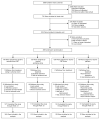Remission after acute treatment in children and adolescents with anxiety disorders: findings from the CAMS
- PMID: 22122292
- PMCID: PMC3371083
- DOI: 10.1037/a0025933
Remission after acute treatment in children and adolescents with anxiety disorders: findings from the CAMS
Abstract
Objective: To report on remission rates in anxious youth who participated in the Child/Adolescent Anxiety Multimodal Study (CAMS). The CAMS, a multisite clinical trial, randomized 488 children and adolescents (ages 7-17 years; 79% Caucasian; 50% female) with separation, social, and/or generalized anxiety disorder to a 12-week treatment of sertraline (SRT), cognitive behavioral therapy (CBT), their combination (COMB), or clinical management with pill placebo (PBO).
Method: The primary definition of remission was loss of all study-entry anxiety disorder diagnoses; additional definitions of remission were used. All outcomes were rated by independent evaluators blind to treatment assignment. Predictors of remission were also examined.
Results: Remission rates after 12 weeks of treatment ranged from 46% to 68% for COMB, 34% to 46% for SRT, 20% to 46% for CBT, and 15% to 27% for PBO. Rates of remission (i.e., achieving a nearly symptom-free state) were significantly lower than rates of response (i.e., achieving a clinically meaningful improvement relative to baseline) for the entire sample. Youth who received COMB had significantly higher rates of remission compared to all other treatment groups. Both monotherapies had higher remission rates compared to PBO, but rates were not different from each other. Predictors of remission were younger age, nonminority status, lower baseline anxiety severity, absence of other internalizing disorders (e.g., anxiety, depression), and absence of social phobia.
Conclusions: For the majority of children, some symptoms of anxiety persisted, even among those showing improvement after 12 weeks of treatment, suggesting a need to augment or extend current treatments for some children.
Figures

Comment in
-
Twelve weeks' sertraline and CBT in young people with anxiety disorders increases likelihood of no longer having the diagnosis compared with placebo or monotherapy, but residual symptoms remain.Evid Based Ment Health. 2012 Aug;15(3):71. doi: 10.1136/ebmental-2012-100729. Epub 2012 Apr 25. Evid Based Ment Health. 2012. PMID: 22535558 No abstract available.
References
-
- American Psychiatric Association. Diagnostic and statistical manual of mental disorders. 4th. Washington, DC: Author; 1994.
-
- Berman SL, Weems CF, Silverman WK, Kurtines WM. Predictors of outcome in exposure-based cognitive and behavioral treatments for phobic and anxiety disorders in children. Behavior Therapy. 2000;31:713–731. doi: 10.1016/S0005-7894(00)80040-4. - DOI
-
- Crawley S, Beidas R, Benjamin C, Martin E, Kendall PC. Treating socially phobic youth with CBT: Differential outcomes and treatment considerations. Behavioural and Cognitive Psychotherapy. 2008;36:379–389. doi: 10.1017/S1352465808004542. - DOI
-
- Derogatis LR. The Brief Symptom Inventory (BSI): Administration, scoring and procedures manual. Minneapolis, MN: National Computer Systems; 1993.
-
- Frank E, Prien RF, Jarret RB, Keller MB, Kupfer DJ, Lavori PW, Weissman MM. Conceptualization and rationale for consensus definitions of terms in major depressive disorder. Archives of General Psychiatry. 1991;48:851–855. - PubMed
Publication types
MeSH terms
Substances
Grants and funding
- R01 MH064092/MH/NIMH NIH HHS/United States
- U01 MH064003/MH/NIMH NIH HHS/United States
- U01 MH064107/MH/NIMH NIH HHS/United States
- R01 MH064003/MH/NIMH NIH HHS/United States
- R01 MH064088/MH/NIMH NIH HHS/United States
- U01 MH064092/MH/NIMH NIH HHS/United States
- MH064092/MH/NIMH NIH HHS/United States
- R01 MH064107/MH/NIMH NIH HHS/United States
- MH64088/MH/NIMH NIH HHS/United States
- U01 MH064089/MH/NIMH NIH HHS/United States
- U01 MH064088/MH/NIMH NIH HHS/United States
- MH64089/MH/NIMH NIH HHS/United States
- U01 MH063747/MH/NIMH NIH HHS/United States
- MH63747/MH/NIMH NIH HHS/United States
- MH64107/MH/NIMH NIH HHS/United States
- R01 MH063747/MH/NIMH NIH HHS/United States
- R01 MH064089/MH/NIMH NIH HHS/United States
- MH64003/MH/NIMH NIH HHS/United States

